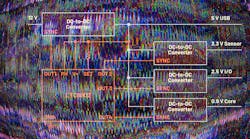Golubovy_-Dreamstime
Members Only Content
Reduce Noise by Synchronizing Switching Regulators (Download)
June 20, 2022
Most of today’s electronic circuits require multiple supply voltages. Twenty years ago, a general-purpose 5-V supply voltage was sufficient for TTL logic and everything else in a system. Today, for example, 2.5 V is needed for the input/output (I/O) of a microcontroller, 0.9 V for the core, and 3.3 V for a sensor. Different voltages also are required for interfaces, e.g., 5 V for USB.
To achieve maximum energy efficiency these days, switching regulators are used for individual dc-dc conversion stages. Figure 1 shows a typical power-conversion architecture.
Comments
Comments
